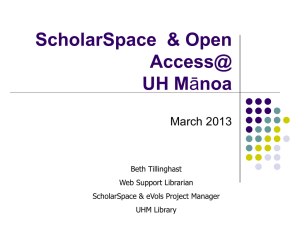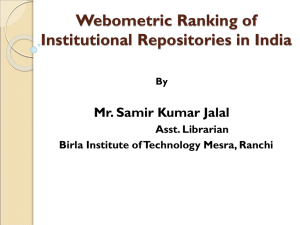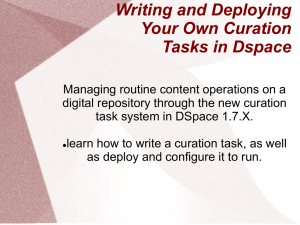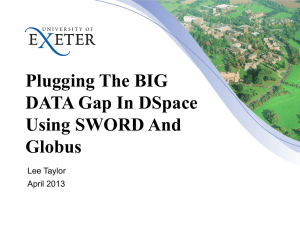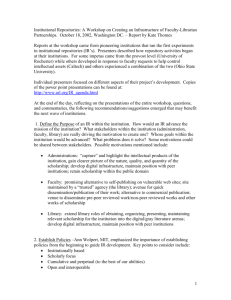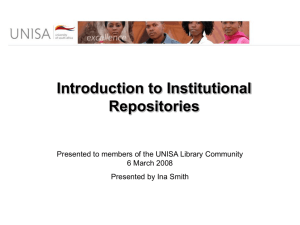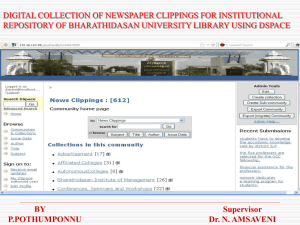Institutional Repositories in India
advertisement
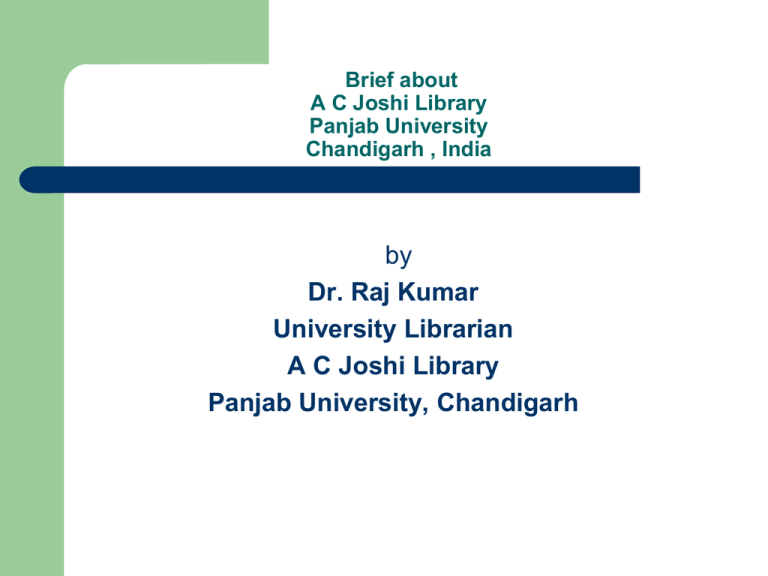
Brief about A C Joshi Library Panjab University Chandigarh , India by Dr. Raj Kumar University Librarian A C Joshi Library Panjab University, Chandigarh Presentation Overview Introduction about A C Joshi Library Overview of E-Resources . RFID Technology implemented in the A C Joshi Library N-LIST Programme About Library •The Panjab University Library, named officially as "A. C. Joshi Library", after the name of an illustrious Vice-Chancellor of this University, was established in the U.S. Club, Shimla in the year 1947 after the Partition of the country. •The Panjab University started shifting its offices to Chandigarh, the new Capital of Punjab, in 1955-56. •Foundation stone of new Library building in Chandigarh was laid in 1958 by Dr. S RadhaKrishnan the then Vice-President of India The Library in its new premises was formally inaugurated in 23 October 1963 by Pt. Jawaharlal Nehru, the then Prime Minister of India. Library Building •The five storied centrally airconditioned impressive Library building in red stone and concrete is a modular structure based on modern principles of architecture. •All the reading areas face the North, the Staff Area is on the South side, with the Stack Area being in between •Its two main Reading Halls facing the Shivalik Hills afford a panoramic view of nature. •Total carpet area of Library is 1,22075 Sq. Ft. with a seating capacity of 600. LIBRARY SECTIONS Rare Books/ Special Section Digital Library Thesis & Text Book Section A C JOSHI LIBRARY Binding Section Circulation Section Reference Section Computer Section Technical Section PU Chandigarh Acquisition Section Transfer Section Periodicals Section Features of A C Joshi Library •A C Joshi Library is considered to be one of the best libraries of India and has been recognised as one of the 6 Document Delivery Centers for data-information-distribution under the UGC-INFLIBNET programme. •Modern library with automation of its routines and services. High-speed servers, scanner, printer and multimedia computers form its IT infrastructure. •Large collection of resources in print, CD-ROM and Online format. •Close Circuit Camera System (CCTV) at the entrance, reading and stack areas. •The Library remains open from 8:00 AM-10:00 PM on all days of the week for 362 days barring 3 national holidays. •An Outer Reading Hall for studying personal books remains open 24 hrs. •Modern well equipped Bindery Library Total Collection Total Collection: 7 Lakhs Back Volumes Journals – 1.24 Lakhs Thesis- 8000 Manuscripts- 1493 Journals Subscribed (Print)- 600 Access to Online Journals- 5000 (through UGC-INFONET and INDEST Consortium) Electronic Resources@PU Library •UGC INFONET Journals •INDEST journals •Science Direct •Web of Science •JCCC@UGC-INFONET E-Journal Gateway •SCOPUS Online Database •WESTLAW Online Database •Wiley Online Books •Proquest Dissertations and Thesis Database •Sage Online Journals JCCC@UGC-INFONET J-Gate Custom Content for Consortium (JCCC) is a Virtual Library of Journal Literature. It acts as a one point access to journals subscribed currently under UGC INFONET and university libraries designated as Inter Library Loan (ILL) Centers. JCCC has facility to trigger e-mail request for article to Inter Library Loan Centers. Inter Library Loan (ILL) Centers: INFLIBNET has identified 22 potential universities (including Panjab University) as ILL Centers. ILL centers fulfill ILL request from the users affiliated to universities covered under UGC- INFONET Digital Library Consortium. Some of the prominent ILL centers are University of Delhi, Jawaharlal Nehru University, Tata Institute of Social Sciences, and University Grants Commission Radio Frequency Identification (RFID) Components: •Patron Self- Checkout •Security Gates •Book Drop •Digital Library Assistant New vistas to preserve scholarly output in higher education system: Institutional Repositories Institutional Repository Digital preservation of the scholarly content is a foremost problem facing by the libraries now-a-days. Academic institutional repositories are the organized collection of digital contents. Digital content confronts with many intimidation including technological obsolescence and the worsening of digital storage media. In this genus of situation, the current expansions of IRs propose some assurance in the long term preservation of digital information. An IR is a service that a research organization offers to its community for the management and dissemination of research materials created by the community members. Need of Institutional Repositories The need to create an IR has been prompted by the reasons such as: – – – – – – – – – – Scholarly communication Storing learning materials and courseware Electronic publishing Managing collections of research documents Preserving digital materials for the long term Added prestige to an institution to showcase its academic research Institutional leadership role for the Library Knowledge management Research assessment Encouraging open access to scholarly research Housing digitized collections Essential Elements of Institutional Repository Institutional Repository can be any collection of digital material hosted, owned or controlled and disseminate by any institution irrespective of purpose of provenance. IR can assume many forms and serve a variety of purposes as per the functions and objectives of parent institution. A digital archive of the intellectual product by the faculty, research staff and students/ research scholar of an institution and it should be accessible to end user without boundaries (with in and out of the institution). The content of an Institutional Repository could be: Institutionally defined: IRs represent historical, tangible and embodiment of the intellectual life and output of an institution. It capture the original research and other intellectual property that is output of institution’s constituent population active in various field of knowledge. The institution needs to be checked the primary quality of the scholarly publication as the repository will be one of the significant indicator of the institution’s academic quality. Therefore, it is essential for the institutions to define it properly. Scholarly contents: The content may be include in an IR are pre prints, pre-reviewed articles, monographs enduring teaching materials, data-sets, conference papers, electronic thesis and dissertation, gray literature and other work in progress. Further, it depends on the goals established by each institution. The institutional repositories could contain any work product generated by the institutions population, which includes students, faculty, non-faculty, researcher and others. Appropriate policies and mechanism are required to control and manage the accession of the contents of institutional repositories. The detailed workflows in respect of who can contribute, approve, access and update the digital content making available by the institutional communities and interests groups. Cumulative and perpetual: The role of IRs become important that the contents collected would be both cumulative and maintained in perpetuity. Interoperability and Open Access: To provide access to research community who belongs to outside institution’s, the IR systems must be able to support interoperability in order to provide access via multiple search engines and other discovery tools. Content, Uses and Issues of Institutional Repositories Mark Ware in his presentation titled “Institutional repositories — the state of play” at the PALS Conference (24 June 2004) has identified the IR content, IR uses and IR issues as below: IR Content USES ISSUES Pre-prints Scholarly communication Sound Policy Post-prints E-publishing Persuading faculty to participate Author post-prints Author recognition Rights management Publisher PDFs Education Organizational and administrative Technical reports Collection management Funding / business model Working Papers Long-term preservation Long-term preservation IR Content USES Theses & dissertations Books or chapters of books Institutional prestige Research assessment Research databases Knowledge management Conference proceedings Text ISSUES Accession policies Open access or Access Control Central vs institutional repositories Metadata Technological Audio/ Video recordings Teaching materials Digital research materials, e.g. simulations, code Unpublished work Data sets Research papers Working papers Stakeholders and their benefits The stakeholders for the IRs identified are the individuals, institutions and the research community at large. The IRs are a platform for the individuals to archive their research work to dissemination and to have a great impact. The institutions can attract high quality faculty, students and funding for its research activities. The IRs are a means of increasing visibility and prestige for universities and research organizations. The research community will be able to access the world’s research available in different IRs, which ensure long-term preservation of institute’s academic output. The IRs can effectively facilitate faster communication process and also avoid unnecessary duplication. Institutional Repository Software A variety of software to create an institutional repository has been used by the Institutions as per their choice, ease of use and based on technology. The software to create an IR may be supported in various ways, like locally supported, centrally supported or commercial support. The challenges in setting up an IR are now seen as being less to do with technology and more to do with managerial, organizational and cultural issues as leading software packages such as DSpace and EPrints are both available free under open source licenses, and there are at least half a dozen other possible packages. The commercial document management or knowledge management software packages for setting up an IR are also suitable but could not take off for adoption due to their costs. DSpace (http://www.dspace.org) software has been designed as a result of collaboration between Hewlett Packard and MIT to offer IR services. It manages diverse heterogeneous types of digital content and offers interoperability via OAI-MHP (Open Archive Initiative – Metadata Harvesting Protocol – a software standard that allows specialised search engines to gather article metadata from compliant websites) and built-in support for Dublin Core metadata. A groundbreaking digital repository system, DSpace captures, stores, indexes, preserves and redistributes an organization's research material in digital formats. Interoperability between systems is built-in and it adheres to international standards for metadata formats. DSpace supports different file formats. EPrints (http://www.eprints.org) package is more oriented towards e-print archives, as the name suggests. It is also OAI-MHP compliant. It does not directly support persistent identifiers (though presumably it does not rule them out). The University of Southampton had developed the EPrints software, which was intended to create highly configurable web-based archive. It is open source software and is free for download. GNU EPrints is an open source software to build, manage and provide access to e-print archives. The technical requirements include UNIX/Linux, based on Perl, built on Apache web server and uses MySQL database. Other packages for creating IRs include the following: CDSware (http://cdsware.cern.ch) developed by CERN and used to run its very substantial CERN Document Server (over 630,000 bibliographic records, including 250,000 fulltext documents); Bepress (http://www.bepress.com/repositories.html): created by The Berkeley Electronic Press for the University of California's eScholarship Repository; Kepler (http://dlib.cs.odu.edu/): The purpose of Kepler is to give any user the ability to easily self-archive publications by means of an "archivelet": a self-contained, self-installing software system that functions as an Open Archives Initiative data provider; Fedora (http://www.fedora.info): Fedora (http://www.fedora.info): an ambitious project developed jointly by Virginia and Cornell with funding from Mellon. Fedora is a general-purpose digital object repository system that can be used in whole or part to support a variety of use cases including: institutional repositories, digital libraries, content management, digital asset management, scholarly publishing, and digital preservation; i-Tor (http://www.i-tor.org/en/toon): i-Tor (http://www.i-tor.org/en/toon): Tools and technologies for Open Repositories was developed by the Innovative Technology-Applied (IT-A) section of Netherlands Institute for Scientific Information Services. i-Tor acts as both an OAI service provider, able to harvest OAI compatible repositories and other databases, and an OAI data provider; MPG eDoc (http://edoc.mpg.de/doc/help/aboutus.epl): MPG eDoc (http://edoc.mpg.de/doc/help/aboutus.epl): developed by the Max Planck Gesellschaft in cooperation with the Fritz-Haber Institute. Currently used by many Max Planck institutes to “capture, document, share, archive, publish, disseminate and manage their scientific documents and the results of their research”; MyCoRe (http://www.mycore.de/engl/index.html): MyCoRe (http://www.mycore.de/engl/index.html): MyCoRe grew out of the MILESS Project of the University of Essen and is now being developed by a consortium of universities to provide a core bundle of software tools to support digital libraries and archiving solutions (or Content Repositories, thus “CoRe”); OPUS(http://elib.unistuttgart.de/opus/doku/english/about_english.php): Online Publications University of Stuttgart. Also used by University of Konstanz; Ebrary (http://www.ebrary.com/libraries/ir.jsp): Ebrary (http://www.ebrary.com/libraries/ir.jsp): the aggregator / database company is offering a “new product that enables libraries to cost-effectively create online institutional repositories of documents such as theses and dissertations, technical reports, e-prints, articles, curricula guidelines and special collections. In preparation, we’re extending a free pilot program to our existing customers and libraries that subscribe to our databases”; Ingenta (http://www.ingenta.com): have already announced a collaboration with Southampton University to develop a commercial version of EPrints. Ingenta say that they have undertaken considerable research into author/university requirements. Greenstone (http://www.greenstone.org): Greenstone is a suite of software for building and distributing digital library collections. It provides a new way of organizing information and publishing it on the Internet or on CD-ROM. Greenstone is produced by the New Zealand Digital Library Project at the University of Waikato, and developed and distributed in cooperation with UNESCO and the Human Info NGO. It is open-source, multilingual software, issued under the terms of the GNU General Public License. Though Greenstone is widely used to build digital libraries, yet some of the libraries have also been using it for creating IR. Institutional Repositories in India The prestigious research institutes and universities in India have developed IRs and more and more universities and research institutes that are creating and managing the IRs is gradually increasing. There are 54 institutional repositories in India registered through the Directory of Open Access Repositories (DOAR – http://www.doar.org), this table indicates the name of the repository, its parent organization, software used and the number of resources they are having. Institutional Repositories in India S.No Name of Repository Organization Software used Number of Items 1. Catalysis Database National Centre for Catalysis Research(NCCR) EPrints 2324 items (2012-09-03) 2. CMFRI Digital Repository Central Marine Fisheries Research Institute (CMFRI) EPrints 8714 items (2012-08-21) 3. Delhi College of Engineering Repository Delhi Technological University, DSpace 326 items (201203-06) 4. Dhananjayarao Gadigil Library Gokhale Institute of Politics and Economics (GIPE) DSpace 1539 items (2012-06-29) 5. Digital Knowledge Repository of Central Drug Research Institute Central Drug Research Institute (CDRI) DSpace 547 items (201209-03) 6. Digital Library at Indian Statistical Institute, Bangalore Indian Statistical Institute, Bangalore Centre (ISI) DSpace 191 items (201206-29) Institutional Repositories in India 7. Dyuthi (Digital repository of Cochin University of Science & Technology) Cochin University of Science & Technology (CUSAT) DSpace 2282 items (2012-09-03) 8. DigitalLibrary@CUSAT CUSAT (Cochin University of Science and Technology) DSpace 5074 items (2012-09-03) 9. DRS at National Institute Of Oceanography (DRS@nio) NICMAS (NIO library), National Institute Of Oceanography (NIO) DSpace 4119 items (2012-09-03) 10. DSpace @ GGSIPU Guru Gobind Singh Indraprastha University DSpace 131 items (2012-09-03) 11. dspace @ sdmcet SDM College Of Engineering and Technology Dharwad DSpace 66 items (201209-03) 12. DSpace at IBS Ahmedabad ICFAI Business School DSpace 171 items (2009-03-13) 13. Dspace at IIT Bombay Indian Institue of Technology, Bombay (IITB) DSpace 14075 items (2012-09-03) Institutional Repositories in India 14. DSpace at Indian Institute of Management Kozhikode Indian Institute of Management Kozhikode DSpace 508 items (201209-03) 15. DSpace at IUCAA Inter-University Centre for Astronomy and Astrophysics (IUCAA) DSpace 2327 items (201209-04) 16. DSpace at NCRA Indian Institue of Technology, Bombay (IITB) DSpace 84 items (201111-10) 17. DSpace at Vidyanidhi University of Mysore DSpace 5482 items (201209-03) 18. DSpace@IMSC Institute of Mathematical Sciences, DSpace 275 items (201209-03) 19. DSpace@INFLIBNET Information and Library Network Center DSpace 1274 items (201209-03) 20. Dspace@NITR National Institute of Technology, Rourkela (NITR) DSpace 1684 items (201209-03) Institutional Repositories in India 21. DSpace@PDPU Pandit Deendayal Petroleum Univeristy (PDPU) DSpace 86 items (201209-03) 22. DSpace@TU Thapar University (TU) DSpace 1840 items (2012-09-03) 23. DU Eprint Archive University of Delhi Eprints 170 items (201206-11) 24. eGyankosh Indira Gandhi National Open University (IGNOU) DSpace 23903 items (2012-09-03) 25. Electronic Theses and Dissertations at Indian Institute of Science Indian Institute of Science, Bangalore (IISc) DSpace 1694 items (2012-09-03) 26. Eprint@NML National Metallurgical Laboratory EPrints 5181 items (2012-09-03) 27. Eprints@IARI Indian Agricultural Research Institute (IARI) 230 items (201209-03) EPrints Institutional Repositories in India 28. EPrints@IITD Indian Institute of Technology, Delhi (IITD) National Institute of Immunology (NII) DSpace 29. ePrints@NII 30. Eprints@SBT MKU School of Biotechnology (SBT), Madurai Kamaraj University (MKU), EPrints 31. Etheses - A Saurashtra University Library Service Saurashtra University EPrints 801 items (2012-0903) 32. ICRISAT Open Access Repository International Crops Research Institute for the Semi Arid Tropics (ICRISAT) N.G. 5695 items (2012-0903) 33. Bhagirathi Mahatama Gandhi Central Library, Indian Institute of Technlogy Roorkee, India DSpace 966 items (2012-0903) 34. Indian Academy of Sciences: Publications of Fellows Indian Academy of Sciences EPrints 88683 items (201209-03) EPrints 2141 items (2012-0903) 10 items (2012-0716) 89 items (2012-0628) Institutional Repositories in India 35. Indian Institute of Astrophysics Repository Indian Institute of Astrophysics DSpace 5627 items (201209-03) 36. Indian Institute of Management Kozhikode Digital Library Indian Institute of Management Kozhikode (IIMK) Greenstone N.G. 37. Indian Institute of Petroleum Institutional Repository Indian Institute of Petroleum Library, Indian Institute of Petroleum, Dehradun DSpace 439 items (2012-0629) 38. Institutional Repository of Intectual Contributions of Delhi Technological University Delhi Technological University DSpace 841 items (2011-0302) 39. Kautilya Digital Repository at IGIDR Indira Gandhi Institute of Development Research (IGIDR) DSpace 204 items (2012-0903) 40. E-Repository@IIHR Indian Institute of Horticultural Research (ICAR) DSpace 206 items (2012-0821) 41. Knowledge Repository Open Network (KNoor) Department of Library & Information Science, University of Kashmir DSpace 580 items (2012-0903) Institutional Repositories in India 42. Librarians' Digital Library (LDL) Documentation Research and Training Centre (DRTC), Indian Statistical Institute, Bangalore Centre (ISI) DSpace 464 items (2012-0903) 43. Mahatma Gandhi University Theses Online Mahatma Gandhi University Nitya 1116 items (2012-0903) 44. Management Development Institute - Open Access Repository Management Development Institute (MDI) DSpace 325 items (2012-0629) 45. National Aerospace Laboratories Institutional Repository Information Centre for Aerospace Science and Technology (ICAST) EPrints 4881 items (2012-0903) 46. National Science Digital Library NISCAIR (National Institute of Science Communication and Information Resources) DSpace 572 items (2012-0903) 47. NOPR (NISCAIR Online Periodical Repository) NISCAIR (National Institute of Science Communication and Information Resources) DSpace 13012 items (201209-03) 48. Open Access Agricultural Research Repository Agropedia, IIT Kanpur N.G N.G Institutional Repositories in India 49. Open Access Repository of IISc Research Publications Indian Institute of Science, Bangalore (IISc) EPrints 33939 items (2012-09-03) 50. OpenMED@NIC Bibliographic Informatics Division, National Informatics Centre (NIC) EPrints 2858 items (2012-09-03) 51. RRI Digital Repository Raman Research Institute, DSpace 5023 items (2012-09-03) 52. ePrints@SVNIT Sardar Vallabhbai National Institute of Technology (SVNIT) EPrints 14 items (201206-29) 53. ShodhGanga: A resevior of Indian Theses Information and Library Network Center (INFLIBNET) DSpace 3385 items (2012-09-03) 54. Vidya Prasarak Mandal Thane Vidya Prasarak Mandal DSpace 1079 items (2012-09-03) Conclusion The IR implementations have been on the increase in academic institutions and research organizations worldwide. Most of the content in IRs is not journal articles and is not self-archived by the authors, but collections are created by libraries as one-time deposits or through periodic batch additions of material. The libraries are harvesting or otherwise mediating deposits, including technical reports, conference papers, student theses and dissertations, images, and nonscholarly publications. In order to make the IR useful and popular among the academic and research community, the faculty should be made aware of the open access movement and existence of IRs; the benefits of archiving; value addition to individuals; and also self- archiving mandates. The most successful IRs are those that strive to engage a diverse set of groups across campus, specifically liaising and serving both academic and non-academic units, accepting a wide scope of content, aligning repository services with the mission of the university, and facilitating new opportunities for knowledge production and publication. Thank you
